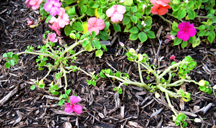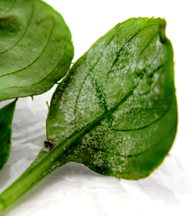Purdue specialist warns of disease deadly to impatiens
May 22, 2013
 |
|
Some impatiens plants in this garden lost their
leaves to downy mildew. (Purdue Department of Botany and Plant Pathology
photo/Janna Beckerman)
|
WEST LAFAYETTE, Ind. - Home gardeners making out their shopping list of annuals to plant should beware of a disease that is inflicting the always-popular impatiens, a Purdue Extension plant disease specialist says.
Janna Beckerman advises gardeners to evaluate the history of their gardens and determine if downy mildew - a disease well-established in the Midwest - was in their yard or in neighboring yards last year before planting any impatiens this year.
"Few plants provide the flowering impact in the shade like impatiens, but gardeners with a history of problems with the disease should consider other plants," she said. "And we need to recognize that this isn't the end of gardening but a reminder to expand your gardening palette."
Beckerman notes that gardeners can choose from literally thousands of flowers.
"Impatiens have become a default option for too many of us," she said. "A healthy landscape and a healthy ecosystem require diversity."
 |
|
The underside of an
impatiens leaf shows downy mildew. (Purdue Department of Botany and Plant
Pathology photo/Janna Beckerman) |
Alternative annuals that do not get downy mildew include New Guinea impatiens, begonia, caladiums, cyclamen, fuchsia, lobelia, perilla, torenia and viola/pansies.
Coleus is another commonly used part-shade annual, but it has its own problems with a different species of downy mildew, Beckerman said. For this reason, coleus is not recommended in gardens with a history of coleus that lost their leaves.
Early symptoms of impatiens downy mildew are difficult to detect: Leaves may be slightly yellow (chlorotic) with stippling and may mimic nutritional deficiency or spider mite damage. Leaves will droop. Under cool, wet, humid conditions, white-colored sporulation may be visible on the undersides of the leaves. Sporulation, however, might not always be visible, especially if conditions are warm and dry.
As the disease progresses, plants appear stunted and foliage drops, resulting in green, leafless stems.
Downy mildew - although sounding like a fungal disease is actually caused by a water mold - can develop in the home landscape in three ways:
* It occurred last year and overwintered on plant residue.
* It was brought in this year on infected plants even though they showed no symptoms of the disease.
* It got blown in by wind and rain from a neighbor's yard.
Moisture, key to the disease, is necessary for the pathogen to produce spores and cause new infections. Places where the leaves stay wet for extended periods, such as with plants grown tightly together, in heavily shaded locations or where watered overhead, create conditions that can drive the disease.
Beckerman said the best strategy for managing a garden is to remove and destroy all infected impatiens to minimize the amount of overwintering inoculum, called oospores, which can potentially start a new epidemic next year if impatiens are replanted in the area.
Gardening still can be fun and rewarding even without impatiens, said Beckerman, who had this final piece of advice for gardeners:
"Most of all, enjoy your gardening even as you lose you 'patiens."
Writer: Keith Robinson, 765-494-2722, robins89@purdue.edu
Source: Janna Beckerman, 765-494-4628, jbeckerm@purdue.edu
Related website:
Purdue University Department of
Botany and Plant Pathology
Ag Communications: (765) 494-2722;
Keith Robinson, robins89@purdue.edu
Agriculture News Page

